Libya
Libya, in long form the state of Libya, is a North African country forming part of the Maghreb. It is bordered to the north by the Libyan Sea (Mediterranean Sea), to the northwest by Tunisia, to the west by Algeria, to the southwest by Niger, to the south-southeast by Chad, to the southeast by Sudan and to the east by Egypt. It covers 1,759,540 square kilometers, placing it fourth in Africa and eighteenth in the world. Its population is estimated between 6 and 8 million inhabitants. It is concentrated on the coasts, the interior of the country being desert. Its capital, Tripoli, is also its largest agglomeration (1.8 million inhabitants), ahead of Benghazi (650,000 inhabitants), Misrata (more than 350,000 inhabitants) and El Beïda (250,000 inhabitants). The majority of Libyans are of mixed Berber-Arab culture and Sunni Muslim faith. Libya’s gross domestic product is one of the highest in Africa. Its economy is largely based on the export of petroleum. She is a member, among others, of the Arab League, the Arab Maghreb Union and OPEC.
Libya takes its name from a Berber tribe which was named Libou, which gave the Greek word Libyè. Traditionally, there are the regions of Tripolitania, Cyrenaica and Fezzan. Originally populated by Berbers, its territory was colonized during Antiquity by the Phoenicians, then the Greeks, before being conquered by the Roman Empire. In the 7th century, it was conquered by the Arab armies, who spread their culture and religion there. After being subjected to various kingdoms during the Middle Ages, it came under the control of the Ottoman Empire in the sixteenth century. The regency of Tripoli became a real state before being directly taken over by the Ottoman Empire in 1835. The last Ottoman possession in Africa, the current territory of Libya was conquered and colonized by the Kingdom of Italy in 1912, at the end of the Italo-Turkish War. During World War II, Italian Libya was invaded and occupied by the Allies. In 1951, it proclaimed its independence in the form of a monarchy led by Idris I. In 1969, a military coup overthrew the king, and the Libyan Arab Republic was proclaimed. From then on, and for almost 42 years, Libya was governed by Muammar Gaddafi. In 1977, the country took the new name of the popular and socialist Libyan Arab Jamahiriya. In 2011, as part of the protest movements in the Arab countries, a rebellion broke out and soon turned into a civil war: with the support of an international military intervention, the rebels overthrew Gaddafi. Libya is however unable, after the fall of Gaddafi, to find political stability and build the rule of law: from 2014, the country sinks into a new civil war while two governments compete for legitimacy.
Libya’s history
Ancient era
From the second millennium BC. AD, the Libous settled in Cyrenaica form a dreaded people of the Egyptians. Around 1000 BC. The first Phoenician trading posts were founded on the Libyan coast. In 631 BC. AD, Greek navigators settled on the Libyan coast. Cyrene quickly established itself as the largest Greek city in Africa. The colonists built their fortune on the trade in silphion or silphium, a plant sought after for its culinary and medicinal properties. Sign of the importance of the city, the monumental temple of Zeus, built in the fifth century BC. Is comparable to that of Olympia. The kingdom of Cyrene will become a republic in 458 BC. AD and then passed under the tutelage of the Ptolemies of Egypt. In the fifth century BC. AD, the Mediterranean coast is dominated by the Carthaginians. In 321 BC. AD, Ptolemy I annex the territories bordering the Mediterranean, which will be ceded to the Romans in 96 BC. AD During the 1st century BC. AD, the three regions that make up present-day Libya (Tripolitania, Cyrenaica and Fezzan) came under the domination of the Roman Empire. Libya, then rich and fertile, became one of the granaries of the Roman Empire. The country begins its decline after the coastal regions were invaded by the Vandals in 455. They were reconquered by the Byzantines from 533.
The Arab-Muslim conquest
In 641, the Arabs, led by Amr ibn al-As, conquered Cyrenaica (linked to Egypt) then Tripolitania (united to Tunisia), gradually Islamized. They only reached Fezzan in 647.
From 644, Tripolitania has no history of its own; subject to the Aghlabids from 801 to 909, it then passed to the Fatimids. In 1050, it was invaded by the Hilalians and definitively ruined, it was then subjected to the Almohades, then to the Hafsides. In 1510, the Spanish occupied Tripoli. In 1551, the Ottoman sultan Suleiman the Magnificent took Tripoli and annexed Libya to the Ottoman Empire. From 1711 to 1835, a dynasty of Turkish-Albanian origin, the Qaramanlis, reigned over Tripolitania as pashas. From then on Tripoli, like Tunis, Algiers, Salé, became a den of pirates practicing corso. Like these cities, it is repeatedly bombarded by European fleets. To punish the Libyan adventurers, American warships, at the beginning of the 19th century, crossed the Atlantic and, following the battle of Derna, occupied the capital of the province of Cyrenaica in 1805.
Ottoman Libya
In 1835, Tripoli was governed by the Karamanli family, who relied on the Arab tribe of Ouled-Sliman. Their abuses decide the people of the oasis to ask the Sultan of Constantinople to transform the nominal suzerainty he had over the country into effective sovereignty. Ottoman troops easily occupied all the ports. Libya then forms two Turkish vilayets. Following the loss of the territory corresponding to current Algeria, conquered by France from 1830, the Ottoman Empire intends to protect its western provinces from the European appetite. In 1843 Sheikh Muhammad al-Sanussi, founder of the al-Sanussiya brotherhood arrived in El Beïda. Tripolitania and Cyrenaica, unlike the other Ottoman provinces of North Africa, remained Ottoman provinces until 1911, the date of the Italo-Turkish War.
Italian colonization from 1911 to 1943
In 1911, the Kingdom of Italy declared war on the Ottoman Empire. Its main goal is to conquer the North African territories of the Ottomans, with the aim of building a colonial empire. A blockade was immediately imposed and Italian troops landed in Tripoli on October 5. They encountered strong Turkish resistance, led in particular by Mustafa Kemal Atatürk. However, on October 18, 1912, the Treaty of Lausanne (also known as the Ouchy Treaty) put an end to the Italo-Turkish War by granting the Italians Cyrenaica and Tripolitania, which form the territory of Italian Libya. After the Turkish surrender, an Arab guerrillas organized against the Italian occupation. Italy sent a contingent of 100,000 men, 4,000 of whom were killed and 5,000 wounded.
The first Libyan autonomous states
In 1918 was proclaimed the Republic of Tripolitania, sovereign state in the western territories of present-day Libya: it was the first Islamic state in the world to have a republican government and the first independent Libyan entity since the fall of the Ottoman Empire. Having experienced hitherto the greatest difficulties in stabilizing their Libyan possessions, the Italians recognized in 1919 the autonomy of the Republic of Tripolitania and did the same a few months later with the Emirate of Cyrenaica, led by Idris, head of the brotherhood of Sanussi. Italy, however, retains the upper hand over the army, diplomacy and justice of the two states. The application of the agreements was quickly hampered by the ill will of all the parties and Italy soon planned to regain direct control of its Libyan possessions. In 1922, Tripolitaine and Cyrenaica returned under direct Italian control, to reintegrate the Italian colonial Empire.
Colonization and resistance
The Emir Idris having fled to Egypt, the supporters of the Sanussi continue to lead in Libya a fierce resistance against the Italians. Until 1931, guerrillas embodied by Sheikh Omar al-Mokhtar continued to oppose the Italian occupation. The capture of the sheikh and his hanging, September 16, 1931, mark the end of the movement.
On January 24, 1932, Benito Mussolini announced the military occupation of all of Libya. Two years later, Cyrenaica and Tripolitania are administratively united in a single province, named Libya, in reference to Roman Antiquity. Italo Balbo was appointed governor general, and led notable efforts to reform the Libyan administration and develop the country’s infrastructure. A road is set up through the desert of Sirte in order to connect the colony from west to east; it was completed in 1937. A large Italian population settled, in particular in Benghazi and Tripoli. At the same time, Mussolini seeks to win over the Arab tribes. A system of limited citizenship is thus put in place.
Second World War
On September 13, 1940, as part of the Second World War, Italian troops stationed in Libya attacked the territory of the Kingdom of Egypt where British troops stationed. They were pushed back and retreated to Tripolitania, before being rescued on February 14, 1941 by an expeditionary force of the German army, the Afrika Korps, led by General Erwin Rommel. The Axis armies regain ground until they threaten to conquer Egypt; however, a counter-offensive led by General Bernard Montgomery forced them to retreat again. In February 1943, all of Italian Libya was occupied by Allied troops, British soldiers and the Free French Forces.
The march towards independence
After the war, France and the United Kingdom shared the occupation of the country: Tripolitania and Cyrenaica under British control, Fezzan under French control. Italy officially renounced Libya in 1947 by the Treaty of Paris. On March 1, 1949, supported by the British who welcomed the emergence of a Libyan monarchy which would remain their ally, Idris al-Sanussi proclaimed the independence of the restored Emirate of Cyrenaica, while the British retained the administration of Tripolitania. The status of Libya is for several months the subject of uncertainty, France being reluctant to the emergence of a new state in the region and preferring to keep the three separate administrations. On November 21, 1949 the United Nations decided the question and declared itself in favor of an independent state including the three Libyan provinces. A year later, Emir Idris was appointed king. On November 25, the first Libyan National Assembly met and on October 7, 1951, a constitution was promulgated.
The Kingdom of Libya and the Discovery of Oil
On December 24, 1951, the United Kingdom of Libya was the first Maghreb state to gain independence. Sidi Muhammad Idris al-Mahdi al-Sanoussi, head of the Sanussi religious brotherhood since 1916, already recognized as emir of Cyrenaica by the United Kingdom since 1946, was proclaimed king of Libya on December 24, 1951 under the name of Idris I . Barely born, the young state nevertheless faces serious problems: a high illiteracy rate (94%), a lack of qualified personnel in most areas and a high infant mortality rate (40%). On March 28, 1953, Libya joined the Arab League. That same year, the government signed military agreements with the United Kingdom, granting that country military bases for twenty years and the free movement of British military vehicles on national territory (territorial waters and air space included) against the payment of 3,750,000 pounds for five years and the promise of technical and military aid. On September 9, 1954, a military protocol was also signed with the United States, allowing the country to maintain several military bases, including the Wheelus Field complex, on the outskirts of Tripoli. These agreements, which provided for the occupation of the bases until 1970, are respected, but not renewed, by the new revolutionary government. Finally, a treaty signed with France on August 10, 1955 enshrined the evacuation of some 400 soldiers who were stationed in the Fezzan region, and cultural agreements were put in place.
Libya joined the United Nations on December 14, 1955. A few months later, on April 30, 1956, drilling carried out in the south-west of the country by Libyan American Oil brought to light a first oil deposit. In 1959, much larger deposits were discovered in Zliten by the company Esso Standard Libya. In 1965, Libya exported some 58.5 million tonnes of “black gold”, via modern facilities (Marsa El Brega terminal). At that time, it was the leading producer in Africa. The oil windfall allows the country to develop its infrastructure, still rudimentary in the early 1960s.
The regime of Muammar Ga
Independent in 1951, Libya passed in 1969, following a coup, under the control of Muammar Gaddafi, a 27-year-old army captain who quickly proclaimed himself colonel and established the Republic. Gaddafi intends to develop a policy claiming pan-Arabism and socialism and attempts numerous “mergers” with his neighbors (Egypt, Tunisia, Chad, Sudan), without success. In 1977, Libya officially became a Jamahiriya, that is to say a “State of the masses” officially governed by means of direct democracy. In fact, Gaddafi – who, after 1979, no longer occupies any position defined in the constitution – governs without any sharing, with the title of “Guide to the Revolution”. An unpredictable character, willingly extravagant in behavior, Gaddafi also wants to be a political thinker and makes his own doctrine, the “third universal theory” – exposed in his book The Green Book – the official ideology of the regime. “Base camps” (Mathabas) were set up from 1980, in an attempt to export the “Jamahiriyan revolution” to neighboring countries. They were not dissolved until 1992. On the domestic level, Gaddafi relies to govern over the power of the tribes and knowingly maintains the disorder of the institutions by constant reforms, thus preventing the emergence of any counter-power. It works to guarantee a form of stability by financing generous social policies thanks to petroleum resources, and by developing Libyan education and health systems. But, at the same time, it relies on a repressive apparatus which uses the most brutal methods, by regularly executing real or supposed conspirators. Gaddafi’s family also plays an increasing political role over the years. The leader, his family and loved ones have unlimited access to Libyan state funds. Muammar Gaddafi has brought tens of billions of dollars out of the country over the years.
Gaddafi Libya is gradually being put on the hot seat by the international community, in particular because of its support for terrorist movements (Irish Republican Army, Red Army Fraction), various guerrilla movements (MPLA) as well as many groups Palestinian armed. Libyan activism particularly affects the countries of sub-Saharan Africa: a dozen of them (Sudan, Burkina Faso, Gambia, etc.) are therefore victims of destabilization attempts, more or less assumed. He also supports the African National Congress (ANC) of Nelson Mandela in South Africa.
Relations with several Western countries, and the United States in particular, were very strained from the early 1980s, and resulted in the sacking of the American Embassy in Tripoli (1980). Indeed, American ships, in the early 1980s, regularly plied the Gulf of Sirte decreed “Libyan inland sea” by Gaddafi: in August 1981, American maneuvers led to an incident, during which two Libyan fighter planes were destroyed in flight. The paroxysm was reached during the bombing of the cities of Tripoli and Benghazi by the American air force (1986), in which the Libyan leader nearly lost his life. The alleged involvement of the Libyan secret services in the Lockerbie bombing, in particular, led to the implementation of a severe embargo from 1992 to 1999. By intelligently managing its oil revenues and operating its industrial transformation, Libya becomes self-sufficient and attractive to African migrant workers who settled massively in the country in the 1990s. Despite Western sanctions, Libya maintains an international policy of Pan-African tradition. It covers most of the costs of building an African communication satellite, commits to UNESCO to finance the project to rewrite the General History of Africa, to pay the contributions of failed States with African organizations and to break the monopoly of Western airlines in Africa through the creation of the Ifriqyiah company in 2001.
International relations normalized in the 2000s. Libya is trying to put an end to the weapons of mass destruction program that has been developed for several years. The Libyan government’s declared hostility to radical Islamists makes it an “ally” in the eyes of George W. Bush, engaged in a “war on terror” and the “rogue states”. Several heads of state or government follow one another in Tripoli (Tony Blair, Silvio Berlusconi, José Luis Rodríguez Zapatero, Jacques Chirac), signing trade agreements in several key areas. The issue of illegal immigration from sub-Saharan Africa is also regularly raised, and leads to an agreement with Libya, which undertakes to contain the migrants against the promise of financial aid from the European Union. Libya is also embarking on a more classical African policy. On August 30, 1999, an extraordinary OAU summit in Tripoli militates for the transformation of the African organization into the African Union. On March 1, 2001, the charter of the African Union was adopted at a summit in Sirte. In the 2000s, Saif al-Islam Gaddafi, second son of Colonel Gaddafi and president of the International Gaddafi Foundation for Charity and Development, advocated a series of political and economic reforms of his father’s regime, advocating in particular the adoption of a real Constitution. His actions are nonetheless objected to by the regime’s “old guard”; Saif al-Islam Gaddafi, often presented as his father’s potential successor, must repeatedly backtrack and struggle to advance his reforms, while remaining one of the main interlocutors of Westerners in Libya. On the eve of the 2010s, Libya still does not have a real Constitution, nor a freely elected political representation.
The fall of Gaddafi
In 2011, following protests in Arab countries, the uprising began with a suicide attack in a barracks which allowed the insurgents to arm themselves. Armed riots broke out on February 13 in Benghazi, the country’s second city, reputed to be the historic cradle of opposition to the regime, won Tripoli on February 20. Human Rights Watch said 173 protesters were killed in four days of fighting. British Foreign Minister William Hague called the violence appalling. However, support from the regime is crumbling: the Libyan representative in the Arab League said that he resigned from his post to join “the revolution”, like his counterpart at the UN, defections in the army were multiply, while tribal leaders demand the departure of Gaddafi and even threaten to cut oil supplies. From the end of February, the insurgents received support from Western powers, notably France, which then delivered them large quantities of weapons during the civil war.
As of February 21, 2011, Benghazi and several other cities in Cyrenaica are in the hands of armed insurgents, while Tripoli is in the grip of clashes but nevertheless remains under the control of government forces. However, the rebellion gained ground and in a few days, according to opponents, the vast majority of the country (half of which is), escaped central power. On February 24, the Libyan branch of the International Federation of Human Rights Leagues Close to the Rebels announced the death toll of 6,000, including 3,000 in Tripoli. From February 25, Tripoli is again won by armed riots, opponents even take control of several peripheral districts of the capital including that of Tajoura. On February 26, 2011, Moustapha Abdel Jalil, former Libyan Minister of Justice, announced the formation of a dissenting interim government from the current government. On March 10, 2011, France quickly became the first country to recognize the National Transitional Council as the legitimate representative of Libya, and envisaged targeted air strikes, in order to fight against what it defined as the repression of Muammar Gaddafi. On March 13, 2011, the loyalist government forces regained ground, and advanced towards the East by investing in strategic cities like Brega or Ras Lanouf, sweeping away the rebels who withdrew in haste to Benghazi. On March 15, 2011, Libyan army forces arrived at the southern gates of Benghazi and began to besiege it.
On March 17, 2011, Alain Juppé, French Minister for Foreign Affairs, speaks in New York in order to convince the UN Security Council to vote for a Franco-British-Lebanese resolution, allowing the use of military means, to ensure a no-fly zone and protect the civilian population by preventing Gaddafi’s troops from being damaged. This resolution is adopted, under Chapter VII of the United Nations Charter, by the Security Council (10 votes for, 0 against, 5 abstentions).
On March 19, 2011, in accordance with United Nations Security Council resolution 1973, an air and naval military intervention was launched by France with Operation Harmattan, followed by the United Kingdom and the United States, supported by the Italy, to establish a no-fly zone and to protect the civilian population from bombing. Several warships and fighter planes are mobilized to destroy the anti-aircraft defenses of forces loyal to Colonel Gaddafi to prevent insurgents and coalition forces from being attacked. Coalition attacks began as Libyan army forces moved into the outskirts of Benghazi and were preparing to take over the city center. The invasion of Benghazi is prevented.
From March until August, the conflict sets in over time. Having become master of the air, NATO, which has taken over from the international coalition, is bombing loyalist positions while the insurgents are conducting operations on the ground. The insurgents manage to keep control of Misrata, the third city of the country, at the cost of a long deadly siege on the part of the loyalist forces. Little by little, they advance from Benghazi to Brega in the East. They also gradually take control of a whole arc of land from the Tunisian border in the West to the surroundings of Tripoli. On August 20, 2011 in the evening, in Tripoli, elements hostile to the regime rose. On August 21, 2011, the first rebel combatants joined them in the battle of Tripoli. On August 22, 2011, the rebels announced that they controlled 80% of the capital. On the evening of August 23, 2011, Gaddafi’s headquarters fell to the rebels. The Gaddafi forces nevertheless remain active in several cities of the country until the fall, before being reduced one after the other. Beni Ulid (October 16, 2011), and especially Sirte (October 20, 2011), will be the last two strongholds to be “liberated” by the rebels. It was while trying to flee Sirte, his hometown in which he had taken refuge, that Gaddafi was captured by a group of rebels and then killed, the exact conditions of his death being still unclear. On October 23, 2011 in Benghazi, the president of the CNT Moustapha Abdel Jalil proclaimed the “liberation” of Libya, officially ending the civil war which had lasted for eight months.
Post-Gaddafi management
Failure of democratic transition The day after the liberation of Libya was proclaimed, Abdel Jalil announced his wish that Sharia law be the basis of future Libyan legislation, which caused concern for the European Union and the United States over respect for human rights in Libya. On October 31, 2011, Abdel Rahim al-Kib was elected president of the Executive Council by the members of the National Transitional Council (CNT). On March 5, 2012, Moustapha Abdel Jalil was reappointed as president of the CNT. On March 7, Cyrenaica proclaims its autonomy from Tripoli and places Ahmed El-Senussi at the head of the Council directing the province, despite the protests of the CNT; the situation then raised fears of a partition of the country. On July 7, 2012, the first democratic election in Libya made it possible to appoint the 200 members of the National General Congress (CGN) responsible for replacing the National Transitional Council. Only 80 members are from nascent political parties, the other 120 are independent candidates, which makes it difficult to determine the political color of the new assembly. Its functioning is also ill-defined, the new constitution still to be written when he takes office. On August 8, 2012, the president of the CNT, Moustapha Abdel Jalil, handed over power to the dean of the CGN in the conference room of a hotel in Tripoli. It is in this room, transformed into a place for parliamentary debates, that the first work of the CGN begins a few days later.
The next day August 9, the new Parliament elects its first president, Mohamed Youssef el-Megaryef; a longtime opponent of Muammar Gaddafi considered a moderate Islamist. A law prohibiting any political responsibility to people who would have exercised it under Gaddafi leads to the ousting of a large part of the political staff: Mohamed Youssef el-Megaryef must thus abandon his post less than a year after his election. In March 2014, Prime Minister Ali Zeidan was deposed by a congressional vote and forced to flee the country. In June 2014, the legislative elections received less than 30% of turnout. In August, the government and the House of Representatives, the newly elected parliament which is to replace the National General Congress but which the Islamists, beaten in the elections, boycott – move to Tobruk, more than 1,000 km from the Libyan capital deemed too dangerous . A few weeks later, the “Dawn of Libya” (Fajr Libya) coalition formed by Islamist groups took control of Tripoli and reformed the National General Congress. Two governments compete for legitimacy: that of the House of Representatives, in Tobruk, and that of the National General Congress, in Tripoli. The Tobruk government is the only one to be recognized by the international community, however.
New Civil War
After the fall of Colonel Gaddafi, Libya is marked by the disappearance of any strong central power: the new authorities fail to impose themselves against the armed militias formed during the revolution. The militias are of three types: very often tribal or local (Misrata, Zintan, etc), sometimes religious (Salafist militias of Benghazi, etc), or personal (private militia of the rebel general Haftar, etc). Libya is crossed by a war between regional and tribal clans which would draw three more important groups with the powers themselves fragmented: the “Great South”, Cyrenaica and Tripolitania. Libya is plagued by violence, political instability and threats of partition, even a new civil war. Assassinations and kidnappings are becoming more and more frequent, with in particular a wave of assassinations in Benghazi in October 2013. On September 11, 2012, the attack on the US Consulate in Benghazi caused several deaths, including the American ambassador . In April 2013, the French embassy in Tripoli suffered an attack. In 2013 and 2014, the United States launched several raids on Libyan territory, without the knowledge of the local government, to capture individuals suspected of terrorism. These operations provoked political crises in the country and the brief kidnapping of the Prime Minister by former rebels. In July 2014, the militia of Misrata allied with Islamist groups confronts the militia of Zenten allied with former supporters of Gaddafi for the control of the airport of Tripoli, while other groups fight in Cyrenaica for the control of the resources oil. In August 2014, Egypt and the United Arab Emirates carried out repeated bombings on the Libyan capital.
At the end of 2014, the country remained divided between Tripoli in the hands of the Islamist and tribal militias of Misrata, which also held many cities, including Derna and the government and the “legitimate” parliament, because they came from the ballot boxes, installed in Al-Baida and Tobruk. The collapse of the Libyan state is helping to make the country one of the main transit areas for illegal immigration to Europe. In 2014-2015, Libya was also faced with the establishment on its soil of the Islamic State, notably in Misrata, Sabratha and Sirte. The International Organization for Migration notes the development of human trafficking in post-Gaddafi Libya. According to the organization, many migrants are sold on “slave markets” for 190 to 280 euros. They are also prone to malnutrition, sexual violence and even murder.
New government in 2016
Given the urgency of the situation in Libya, and the rise of the Islamic State, the international community is pushing for the formation of a new government. After several months of negotiations, Fayez el-Sarraj officially formed, on March 12, 2016, a government of “national unity”, initially rejected by the parliaments of Tripoli and Tobruk. Thanks to the support of Westerners, this government can settle down at the end of March in Tripoli; he then obtained a favorable vote from the parliamentarians of Tobruk, and gradually installed his authority. The takeover of the city of Sirte from the Islamic State (IS) in North Africa, of which it was the stronghold, at the beginning of December 2016 by the forces of the Libyan government of national unity of Faïez Sarraj, supported by the western capitals and the United Nations, stops the speed of ISIS in this country. On the other hand, the situation remains blocked between Prime Minister Fayez el-Sarraj from the government of national agreement (GAN) and the head of the Libyan National Army (ANL) of Khalifa Haftar. Diplomatic mediations between these two parties follow one another, in France, in July 2017 in La-Celle-Saint-Cloud, in France still in May 2018 at the Elysée Palace, then in Palermo in Italy in November 2018, giving hope for the resumption of a dialogue. But the military assault launched in April 2019 by troops of the Libyan National Army (LNA) of Khalifa Haftar on Tripoli, pulverizes the hopes of a political settlement in the short term. Each of the forces present increases contacts and alliances with outside powers. A new diplomatic initiative, this time Turkish-Russian, to obtain the signing in Moscow of a cease-fire in Libya is coming to a halt in January 2020.
Libya’s politics
Brought to power by a coup in 1969, Muammar al-Gaddafi established the Libyan Arab Republic, a socialist-inspired regime, on the model of Egypt led by Gamal Abdel Nasser, governed by a Revolutionary Command Council . In 1973, popular committees were created, designed as places for the exercise of direct democracy. In 1977, a new constitution, known as the Declaration on the Advent of People’s Power, gave Libya’s mode of government the official name of the popular and socialist Libyan Arab Jamahiriya (Jamahiriya being a neologism translatable by the State of the masses) in which the Executive power is shared between the Guide to the Revolution and sixteen representatives of the General People’s Congress, which is the legislative body, and its political bureau. From February 2011, this power was challenged by an insurrection which started in Benghazi and spread over a large portion of Libyan territory. The rebels and the regions they control are led on February 27 by a National Transitional Council (CNT) chaired by former Minister of Justice Moustapha Abdel Jalil. After August 22, 2011, the rebellion also controlled almost the entire Libyan capital, reducing the former power of Gaddafi to a bare minimum. Beni Ulid and Sirte, the last bastions of Gaddafi, fall in the fall; Muammar Gaddafi himself is captured and killed while trying to escape from Sirte.
Libya then entered a difficult period of political transition. A provisional “constitutional declaration”, adopted on August 3, 2011, defines Libya as “an independent democratic state where all powers depend on the people” and plans to guarantee political and religious pluralism, while basing Sharia law. The CNT announces that it does not plan to keep power until the meeting of a constituent assembly, which will have to designate a new government and draft a constitution, then submitted to referendum, prior to free elections. On July 7, 2012, a National General Congress was elected by universal suffrage. As of its first meeting on August 8, it replaced the CNT and was responsible for designating a new transitional government, pending the establishment of the final institutions. The new regime, however, is experiencing the greatest difficulties in forming a strong central authority, and must contend with numerous tribal or regional armed militias, in particular Islamists, which were formed during the civil war and threaten the partition of the country. The country soon appeared as a “failed state”. In 2014, after the holding of legislative elections in June, Libya, which still has no real constitution, sinks into a new civil war: two rival governments, that of the House of Representatives resulting from the legislative elections, in Tobruk , and that of the National General Congress, dominated by Islamists, defeated in the elections, in Tripoli.
Libya’s economy
When it gained independence in 1951, Libya, both isolated and devoid of natural resources, was one of the poorest countries in the world. Its economy is dominated by agriculture mainly practiced in the coastal regions which then employs 70% of the active population and provides about 30% of the gross national product (GNP) while being very dependent on climatic factors. The discovery in 1958 of large oil fields transformed the country’s economy. Oil production grew very rapidly, reaching 3 million barrels per day during the 1960s, making Libya one of the main exporters. It is accompanied by a very rapid rise in the standard of living: in the 1970s Libya’s per capita GNP was the highest in all of Africa. However, throughout the Gaddafi period, the economy was hampered by its interventionist nature (in 2005, the private sector represented only 2% of GNP102) as well as by international sanctions.
The weight of oil
Libya is in ninth place in the list of OPEC producers during the 2010 decade, behind Saudi Arabia and Iraq, Iran and the Emirates, but also Kuwait, Nigeria and Venezuela. It is also the third largest producer of crude oil in Africa after Nigeria and Angola, ahead of Algeria. But Libya has the largest oil reserve in Africa, its reserves are estimated at 46.4 billion barrels in 2011. Libya is therefore a major player in the Organization of the Petroleum Exporting Countries (OPEC). Libyan oil is of high quality, inexpensive to produce and close to consumption centers. The production capacity is partially handicapped by the low investment linked to the embargo which was lifted only in 2003 and which resulted from the economic sanctions decided by the Security Council of the United Nations in 1986 and extended in 1993.
In 2005, oil supplied 93% of the country’s revenues and 95% of its exports. The share of oil revenues in GNP is particularly high since it is twice that of Saudi Arabia and triple that of Iran. In 2006 production was 1.8 million barrels per day (2010) mainly concentrated in the Sirte basin of which 270,000 are consumed on the spot and the rest exported mainly (85%) to European countries. The petroleum industry is managed by the national public company National Oil Corporation (NOC) which has a majority stake in all consortia set up with foreign oil companies in the field of exploration, production and refining. Libya also has significant reserves of natural gas (1,548 billion m³) which have so far been little exploited: 28 billion m³ (2009) are produced and half is used in the country, in particular in power stations. electrical production. Part of the gas is exported to Italy via the Greenstream pipeline. Libya has five refineries with a total processing capacity of 378,000 barrels per day. The two largest are in Ras Lanouf (220,000 bbl / d) and Zaouïa (120,000 bbl / d). Oil is the country’s almost unique resource, which remains highly dependent on foreign countries for everything else. Oil contributes directly to the formation of the GNP up to 35%, the service sector represents 45% of the GDP, construction 7%, industry 7% and agriculture 8% (2005 figures).
Other economic sectors
About 1% of the area of Libya is cultivated and 8% allows grazing. The areas receiving between 250 and 500 mm of annual precipitation represent 9,400 km2 in the Djeffara and Djebel Nefoussa regions in the west and 13,000 km2 in the Benghazi and Djebel Akhdar region.
The Djeffara region is the only one with an agricultural tradition. The main crops are wheat, barley, tomatoes, lemons, potatoes, olives, figs, apricots and dates. Projects to expand agricultural production using the abundant fossil water reserves (Great Artificial River project) have not yielded significant results. Despite the will of its leaders, Libya is completely dependent on imports to feed its population. The industry focuses on the processing of agricultural products, the production of textiles, cement, steel from imported iron ore and aluminum. Production units are often in poor condition and underused. Despite good potential (desert with spectacular landscapes, dense network of well-preserved ancient cities, coast suitable for seaside tourism), tourism is underdeveloped (around 300,000 tourists in 2003 according to official statistics) because it lacks reception facilities and companies dedicated to this activity.
Infrastructure
Libya has a 47,900 km network of paved roads and two international airports at Benghazi and Tripoli. There are plans to link the main coastal cities of Tripolitania by normal rail, but in 2011 Libya had no rail infrastructure. Ports are located in Al Khums, Benghazi, Darnah, Marsa al Burayquan, Misratah, Ras Lanuf, Tobrouk, Tripoli and Zuwarah. The country has a network of 4,983 km of pipelines for the transport of crude oil, 443 km for refined petroleum products and 1,947 km for gas.
Libya’s demography
Libya has a total population of 6.6 million. This population was 1.09 million in 1951, 2.06 million in 1964 and 3.6 million in 1984. Due to a growth rate of 3.3% over the period 1960-2003, one of the most high in the world, half the population is under the age of 15. However, the demographic transition has started with a growth rate which has fallen to 2% and a crude birth rate reduced from 49 per thousand to 27 per thousand in 2003. Most of the inhabitants live in a narrow coastal strip. The density thus reaches 50 inhabitants per km² in the regions of Tripolitania and Cyrenaica but falls to less than one person per km² in the rest of the country. 90% of the population is concentrated on 10% of the area. The urban population, which made up 45% of the total in 1970, represented 86% of the population in 2003, one of the highest rates in the world. The population is concentrated mainly in the three largest cities of the country Tripoli, Benghazi and Al Bayda. Tripoli (1.5 million inhabitants), the capital of the country and the region of Tripolitania, is an ancient city which dates back to Antiquity (Oea). It brings together a part of the central administrations, plays a major commercial role, in particular thanks to its port and a network of small and medium-sized enterprises. The capital is at the center of a fairly dense network of small and medium-sized cities dominated by Misrata and Zaouïa, which today absorbs most of the region’s demographic growth.
Benghazi (700,000 inhabitants), the regional capital of Cyrenaica, was only a small town of 2,000 inhabitants at the end of the 19th century in the heart of a region dominated by pastoralism. It experienced a certain growth during the conquest by Italy of the region in 1932 which led to the cultivation of the hinterland relatively well watered. But it mainly took off with the discovery in 1959 of the oil fields that border the Gulf of Sirte located about 200 km from the city. Oil companies install their administrative services and repair workshops there, which leads to rapid development in the secondary and tertiary sectors. Cyrenaica also has four other cities of a hundred thousand inhabitants each: Tobrouk, the only natural port in the country, Ajdabiya, Al Bayda and Darnah. The Saharan part of the country has some major agglomerations. Koufra in the heart of the Libyan desert and 900 km from the Gulf of Sirte owes its development to the desire of the Libyan government to exploit the resources of the water table, but above all to its role as a commercial crossroads on the road leading to Chad and Sudan . Sabha (120,000 inhabitants) located on the trade route to Eastern Sahara has benefited from a proactive decentralization policy of the Libyan state and serves as a hub for a partly informal trade where food and manufactured products are exchanged.
The Libyan population is mainly composed of Arabs, Berbers, Arabized Berbers and descendants of Turks. A small number of Hausa and Toubous tribal groups in southern Libya practice a nomadic or semi-nomadic lifestyle. Libya receives a large number of foreign emigrants, the majority of whom are from Egypt and sub-Saharan Africa. 6,000 Italians are partly the descendants of former settlers, the majority of whom left the country when he gained independence in 1947 and especially in 1970 after Gaddafi came to power. Part of the immigrants, mostly Egyptian and from sub-Saharan Africa, are illegal.
The Berber speakers live mainly in Jebel Nefoussa in the Tripolitania region, in the city of Zouara on the coast and in the oasis cities of Ghadames, Ghat and Awijilah. The Toubou languages are spoken by speakers to the villages of Katroun and Koufra. Italian and English are sometimes spoken in large cities, especially by the older generations for Italian. According to the 2008 World Refugee Report published by the US Committee on Refugees and Immigrants, Libya was home to a refugee and asylum-seeker population of 16,000 people in 2007. Of that number, about 9,000 people come from Palestine, 3,200 from Sudan, 2,500 from Somalia and 1,100 from Iraq. There are around 140 tribes and clans in Libya. The majority of the population, which once had a nomadic lifestyle and slept in tents, now lives in cities in buildings and houses, making traditions disappear. A small number of Libyans continue to live in the desert with their families as they have done for centuries. Most of the inhabitants are employed in industry, the tertiary sector and a small fraction of the population in agriculture.
Libya’s education
Under Gaddafi’s regime, education in Libya accommodates 1.7 million people, including 270,000 students. Education is free for all citizens and compulsory up to secondary level. The literacy rate, with 82% of the population able to read and write, is the highest in North Africa. After Libya’s independence in 1951, the country’s first university opened its doors in Benghazi125. The number of students in 1975/1976 reached 13,418 and increased to 200,000 in 2004, to which must be added 70,000 people following higher technician or professional training. The rapid growth in enrollment has resulted in a parallel increase in the number of higher education institutions. Since 1975 the number of universities has increased from 2 to 9 and the number of vocational training institutes and higher technicians (whose appearance dates back to 1980) has increased to 84. Higher education is financed mainly by the budget national and represents 38.2% of it. The main Libyan universities are: University of Tripoli in Tripoli; Benghazi University in Benghazi; Omar Al Mukhtar University in Beida. Private universities Libyan International Medical University The main technological institutes are: the Higher Institute of Computer Technology in Tripoli; the Higher Institute of Electronics in Tripoli.
Libya’s language
The main language used is Arabic (Libyan Arabic) spoken by 80% of Libyans as well as modern standard Arabic, which is also an official language. The Berber language is also an official language, are used by 20% of the population (Libyan Berbers and Touaregs): The majority of the Berber-speaking population is concentrated in the north-west: in Djebel Nafoussa (where nafusi is spoken there) , the Yefren region and the coastal town of Zouara. The Berber language is also spoken in certain oases such as Soknah and Awijlah; the tamahaq in the Ghat region by about 17,000 people and the zenet in the Yafran region.
Foreign languages
The main foreign language, spoken as a second language, is English, which is also the most spoken language of the upper classes. Italian has more than 50,000 second language speakers, especially in Tripolitania. At one point, Italian was the second language of the over 65s who had known Italian colonization. Italy having become the first trading partner, the Italian has been gaining strength for a few years, especially since the lifting of the embargo of the years 1990/2000. French is sometimes spoken. Turkish, very marginal, with a low number of speakers, remains a language of culture: Tripolitania and Cyrenaica have long been dependent on the Ottoman Empire, before 1912. Young people are now turning to Western languages: English for the most part, Italian and French. The other languages taught in universities are German, Chinese, and Russian.
-
Libya
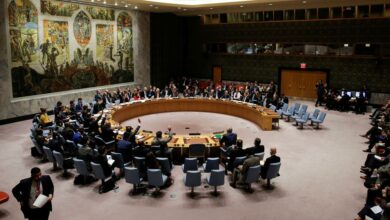
UN Envoy To Libya Says Proposed Electoral Laws Not Enough To Enable Election
The United Nations (UN) envoy to Libya, Abdoulaye Bathily, on Monday, said the electoral laws agreed by a committee of…
Read More » -
Libya
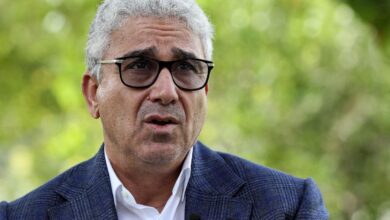
Libya’s Eastern-Based Parliament Suspends It’s Prime Minister Fathi Bashagha
Libya’s eastern-based parliament on Tuesday voted to replace its appointed Prime Minister Fathi Bashagha, the parliament spokesperson Abdullah Belhaiq confirmed,…
Read More » -
Libya
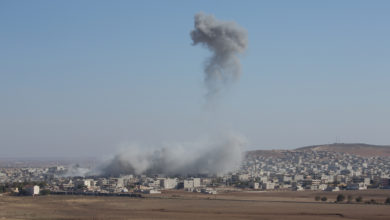
UNSMIL Warns Explosive Ordnance Left By Armed Conflict Poses Major Risk To Libyans
The United Nations Support Mission in Libya (UNSMIL) on Tuesday warned that explosive ordnances left by armed conflicts pose a…
Read More » -
Libya
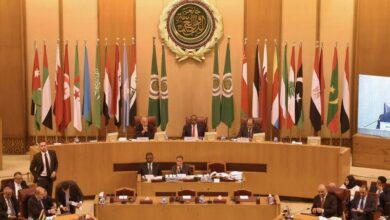
UN Libya Envoy Points To Alternatives If No Electoral Pact Is Finalized Soon
The United Nations (UN) envoy to Libya on Friday said if Libya’s legislative bodies fail to agree on electoral laws…
Read More » -
Libya

UN Special Representative To Libya To Launch New Effort To Break Political Stalemate
The United Nations (UN) special representative to Libya on Monday said he will launch a new initiative to enable elections…
Read More » -
Libya
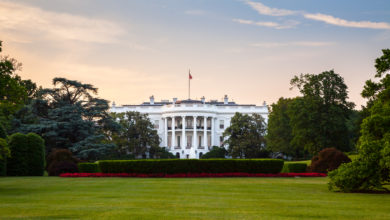
US Piles On Pressure On Allies To Expel Russia’s Wagner Mercenaries From Libya, Sudan
The United States (US) continues to pile on the pressure on Middle East ally countries to expel the Russia-based military…
Read More » -
Libya

UN Human Rights Mission: Silence From Libyan Authorities No More Acceptable
The United Nations (UN) Human Rights Council on Monday urged the authorities in Libya to share more information on mass…
Read More » -
Libya

UN Envoy To Libya Bathily Calls For International Help To Resolve Libya’s Crisis
United Nations (UN) envoy to Libya, Abdoulaye Bathily, on Sunday called for international support to help the country overcome the…
Read More » -
Libya
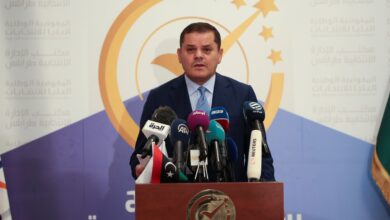
Libyan Prime Minister Dbeibah Says His Government Ready To Hold Elections In 2023
Libyan Prime Minister Abdul-Hamed Dbeibah on Monday said his Tripoli-based government is all set to hold general elections in the…
Read More » -
Libya
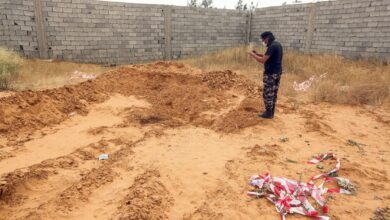
Libyan Authorities Discover Mass Grave With 18 Bodies In Former Islamic State Stronghold
Libyan authorities on Sunday said they have discovered a mass grave with 18 bodies in the Sabaa area of Sirte…
Read More » -
Libya
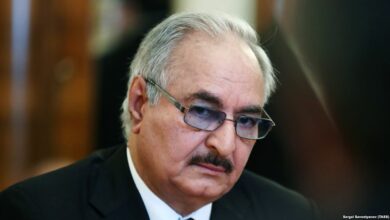
Libyan Eastern Commander Announces Final Opportunity To Hold Elections
Libyan eastern commander Khalifa Haftar on Saturday announced a final opportunity to chart out a road map for elections, reported…
Read More » -
Libya
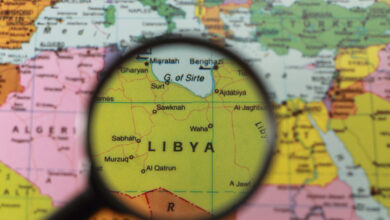
UNSMIL Strongly Condemns Heinous Killing Of At Least 15 Migrants In Libya
The United Nations Support Mission in Libya (UNSMIL) on Sunday strongly condemned the heinous killing of at least 15 migrants…
Read More » -
Libya

Western Countries Reiterate Support To Hold Election In Conflict-Hit Libya
Western countries have reiterated support to hold presidential and parliamentary elections in the conflict-hit Libya as early as possible, reported…
Read More » -
Libya

Libya’s Health Ministry Reports Death Of 32 People In Recent Deadly Clashes
Libya’s health ministry on Sunday said at least 32 people were killed and more than 150 got injured in clashes between…
Read More » -
Libya
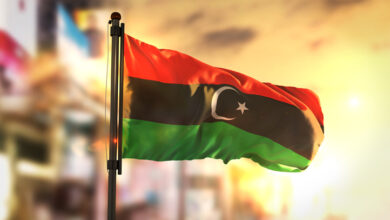
UNSMIL Expresses Deep Concern Over Mobilization Of Forces In Tripoli
The U.N. Support Mission in Libya (UNSMIL) on Tuesday voiced deep concern regarding the ongoing mobilization of forces in Tripoli…
Read More » -
Libya

UN Security Council Extends Political Mission In Libya For Just Three Months
The United Nations (UN) Security Council on Thursday voted to extend its political mission in Libya for only three months…
Read More » -
Libya
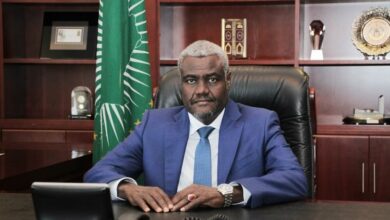
AU Urges Rival Libyan Factions To Exercise Restraint Following Deadly Clashes
The African Union (AU) has urged rival factions to exercise restraint following clashes between armed groups loyal to Libya’s rival…
Read More » -
Libya

Libya’s PM Fathi Bashagha Planning To Take Office In Tripoli In Coming Days
Libya’s Fathi Bashagha, who was appointed as prime minister in a challenge to Tripoli’s interim unity government, has said that…
Read More » -
Libya
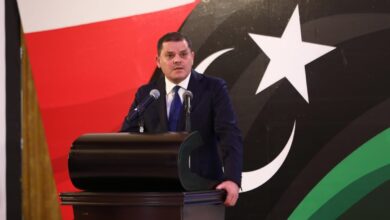
Libya’s UN-backed Government Head Supports Protesters, Calls For Election
Libya’s United Nations-backed government leader Abdulhamid al Dbeibah on Friday said he supports protesters in the country, reported The TRT…
Read More » -
Libya
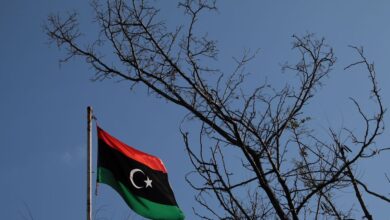
UN Calls For Final And Courageous Effort As Rival Libyan Leaders Begin Negotiation Talks
The United Nations (UN) called for a final and courageous effort to break the deadlock over the long-awaited elections in…
Read More » -
Libya
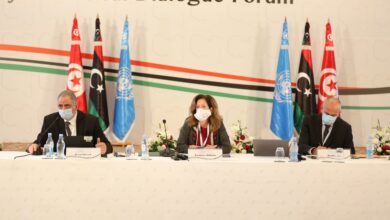
UN Brokers Meeting Between Rival Libyan Government Heads In Cairo Next Week
The United Nations (UN) on Thursday announced it has arranged for talks between the heads of Libya’s two rival governments…
Read More » -
Libya

Libya’s Rival Factions Begin Third Round Of Talks In Egypt’s Capital Cairo
The third round of talks between Libya’s rival east and west administrations began in Egypt’s capital Cairo on Sunday, reported…
Read More » -
Libya

HRW Appeals ICC To Investigate Russia’s Wagner Group’s Crimes In Libya
Human Rights Watch (HRW) on Tuesday made an appeal before the International Criminal Court (ICC) to investigate allegations of the…
Read More » -
Libya

Libyan Rival Prime Minister Bashagha Says He Has No Plans To Rule From Tripoli
Libyan rival Prime Minister, Fathi Bashagha, has said he is not planning to rule from Tripoli after his attempted move…
Read More » -
Libya
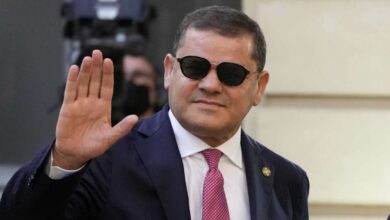
Libyan Prime Minister Says He Will Step Down After New Government Is Formed
Libyan Prime Minister Abdul Hamid Dbeibah on Wednesday suggested starting preparations for the June elections and holding parliamentary elections at…
Read More »

